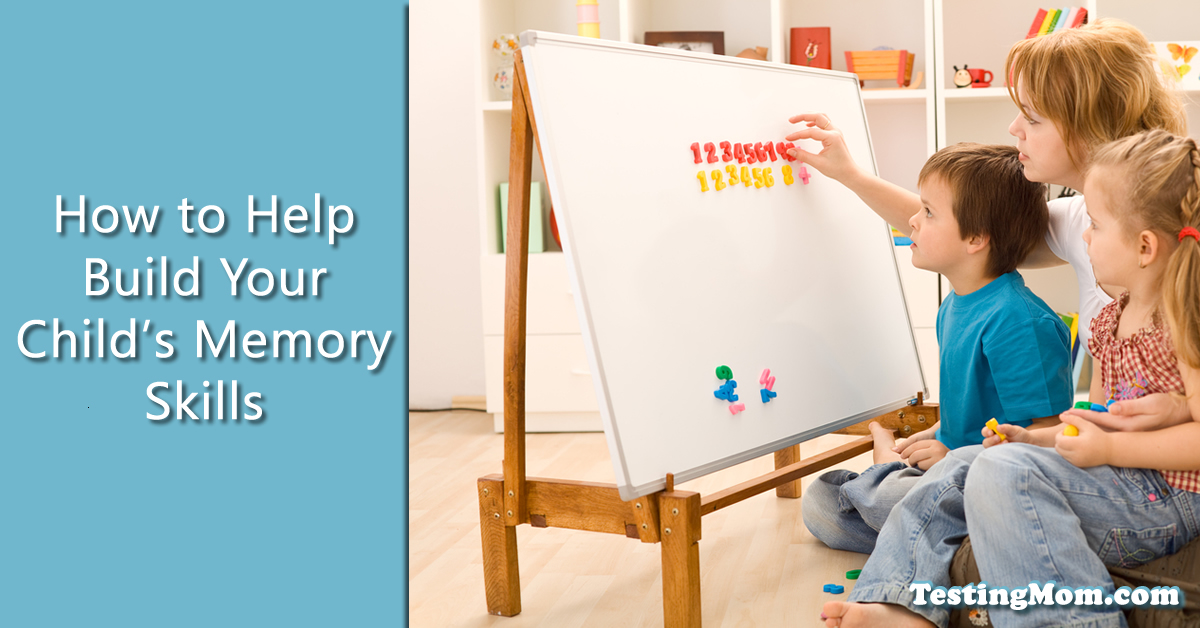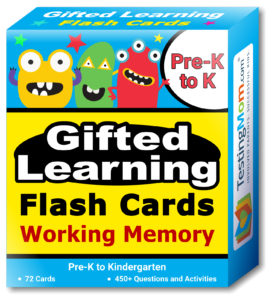› How to Help Build Your Child’s Memory Skills
How to Help Build Your Child’s Memory Skills
posted by Karen Quinn, The Testing Mom - August 2nd, 2019
How to Strengthen Your Child’s Memory
As Dr. Mel Levine contends, “More memory is needed for school success than is required in virtually any career.” That’s why you want to work on your child’s memory skills in the formative years to set a strong foundation for the future.
For kindergarten and testing success, children need three kinds of memory:
short-term memory to follow directions,
working memory to manipulate information,
and long-term memory to retrieve information learned in the past.
Because memory is fundamental to all higher-order thinking, you can’t think, reason, hypothesize, solve problems or make decisions without it!
Short-Term Memory
So, let’s start with short-term memory, which is your child’s ability to retrieve information he/she was given in the last few seconds. For example, you can say, “Can you repeat the numbers and letters I say? J, F, 6, 3, Z,” and your child will repeat “J, F, 6, 3, Z.” This is important for school success because a child is expected to listen to the teacher, answer the question and follow directions – this is the model of every classroom in the world. Similarly, when your child is tested, he/she will be expected to listen to the examiner’s instructions, then complete the requested task. During testing, however, some questions cannot be repeated, so it’s imperative that your child listens and remembers the directions.
To build upon short-term memory there are several fun things you, as a parent, can do including the verbal game, “I’m Going Camping,” where you say: “I’m going camping and I’m taking a flashlight.” Your child will then add, “I’m going camping and I’m taking a flashlight and marshmallows,” and then you each continue to add to the list – and every list can be silly, which makes it creative and funny. But if someone can’t remember or add to it, then they’re out of the game! Another fun game is memory patterns where you create a visual pattern with anything…blocks, shells, macaroni, etc., where you might have two blocks, five shells, and three pieces of macaroni in a row. Then, cover it up and see if your child can recreate it from memory. And as your child progresses, so does the length of the pattern.
Working Memory
Next, there’s working memory, which is your child’s ability to retrieve information he/she was just given, hold on to it in short-term memory, and then do something with it. Similar to the previous example, you could simply add to it by saying, “Listen to the letters and numbers that I say, then repeat them back to me with the letters first and the numbers second…J, F, 6, 3, Z.” Your child should then say, “J, F, Z, 6, 3.”
Working memory is critical for academics because tasks involve taking in information and processing it. For example, a child may read a story or section in a textbook and be asked to answer questions about what was read. When sounding out a long word, a child must remember what the first part of the word is until he/she reaches the end of the word.
When developing the working memory, it’s good to connect emotion to information, because processing information in as many ways as possible can help your child remember it. If you can connect feelings to the thing that’s being remembered, it makes it easier. For instance, if your child’s reading about walking Clifford the dog in the rain through some puddles, ask your child to think about what it might feel like to have to walk a dog in the cold rain without rain boots while Clifford rapidly drags you through puddles.
Long-Term Memory
Lastly is long-term memory, which is your child’s ability to retrieve information learned in the past or after a delay. Long-term memory is critical to school success because kids are expected to remember vocabulary, spelling, grammar rules, multiplication tables, history, state capitals, etc., and are constantly expected to recall and add to whatever they previously learned.
There are tons of fun ways to work on long-term memory! One of my favorites is what I call “All About Me,” where you help your child learn and remember important information about him- or herself, including first and last names, address, phone number, birthday, etc. I like to create a rhyme to memorize, like: “I live on Third Avenue and my favorite dinner is beef stew!” Or set it to a tune like “Mary Had a Little Lamb” and sing, “I live in Apt. 3C, Apt. 3C, Apt. 3C, I live in Apt. 3C at 127 Third Avenue!”
A tester may ask, “Why do we brush our teeth?” and your child will remember mom or dad saying that we clean our teeth to avoid cavities and share that information with the tester. That’s an example of long-term verbal memory. The tester may also show your child a picture of a woman driving in an upside-down car and ask, “What’s wrong with this picture?” If the child says, “Cars don’t drive upside-down,” he or she is using long-term visual memory.
I hope these memory techniques serve you well!
Did you know?
We have some great Working Memory Flash Cards for your Preschooler and Kindergartner that will help? Check them out HERE!





Tell us about your experiences